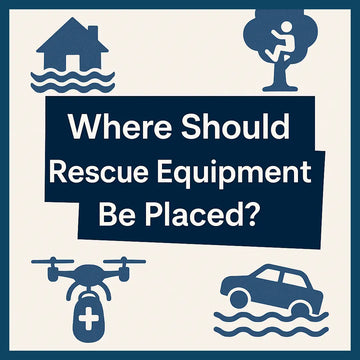In emergency response, the strategic placement of rescue equipment is paramount for saving lives and reducing risks to both victims and rescue personnel. This blog explores how to effectively and scientifically allocate rescue assets—from advanced air-water dual-role drones to traditional emergency tools—across various environments to maximize response efficiency and safety.
1. The Importance of Rescue Equipment and Deployment Principles
1.1 The Role of Rescue Equipment
Rescue equipment plays a critical role in emergency response by ensuring rapid intervention, minimizing hazards for first responders, and providing effective means to save lives during disasters such as fires, floods, or traffic accidents. Well-planned equipment deployment ensures that help arrives quickly when seconds count.
1.2 Fundamental Principles of Deployment
-
Broad Coverage: Deploy assets in key areas such as densely populated zones, tourist hotspots, water bodies, and major thoroughfares.
-
Rapid Response: Placement should allow for immediate accessibility, reducing response times during emergencies.
-
Adaptability to Environment: Choose and position equipment suitable for specific scenarios—water-based, aerial, or high-altitude rescues—by focusing on features like waterproofing, lightweight construction, and remote operability.
-
Integrated Technology: Combine rescue devices with drone technology, smart control systems, and real-time monitoring to create an efficient, interconnected emergency network.
2. Strategies for Deploying Rescue Equipment in Various Environments
2.1 Water-Based Rescue Zones
Modern rescue solutions increasingly emphasize water operations. For example, the JX-6A air-water dual-role drone system is designed for:
-
Rapid Water Takeoff and Landing: Ideal for rivers, lakes, and ocean environments, enabling swift rescue actions.
-
High Buoyancy Support: With a buoyancy force of up to 190N, it can support multiple water landings and takeoffs.
Deployment Recommendations:
-
Around Rivers and Lakes: Prioritize placement near tourist areas, wetland parks, and popular water recreation sites.
-
At Ports and Seaports: Equip regions with high maritime activity, such as oil platforms, yacht harbors, and coastal facilities.
-
Urban Flood Zones: Position equipment near low-lying urban areas and critical drainage systems to address potential flood emergencies rapidly.
2.2 Urban and High-Altitude Rescue
Rescues in high-rise buildings or elevated terrains pose unique challenges. Key considerations include:
-
Roof and High-Risk Areas: Place rescue equipment on rooftops or near emergency exits to facilitate quick access during crises.
-
Tree Canopies and Cliff Edges: For incidents occurring in difficult terrain, portable rescue tools combined with drone-assisted operations can help extract victims safely.
2.3 Roadways and Transportation Hubs
Urban environments, particularly highways and transit centers, are common sites for accidents and fires.
Deployment Recommendations:
-
Main Roads and Intersections: Equip high-risk intersections and segments with emergency kits and rescue devices.
-
Public Venues and Large Event Areas: Ensure areas like stadiums, convention centers, and shopping complexes have accessible emergency tools.
-
Integration with Traffic Monitoring: Utilize centralized control centers that connect with emergency services, allowing real-time coordination during critical events.
3. Advantages of Modern Smart Rescue Equipment
3.1 The Role of Drone Rescue Systems
The modern air-water dual-role drone, exemplified by the JX-6A system, can significantly enhance rescue efforts due to its:
-
Precision and Control: Featuring a single-axis gimbal camera that provides live video feeds to the command center, allowing for accurate situational assessments.
-
Environmental Adaptability: Capable of operating in wind speeds up to level 6 and under moderate sea states, ensuring effective operations in challenging conditions.
-
Automated Return Functions: With an operational range exceeding 1,100 meters, the drone is programmed to return to base automatically if communication is lost, thereby reducing additional risks.
3.2 Building Integrated Smart Monitoring Systems
Intelligent integration of rescue equipment with real-time monitoring and data management systems supports dynamic and coordinated emergency responses. GIS technologies and big data analytics enable responders to identify high-risk areas and deploy resources more efficiently.
4. Implementing an Effective Rescue Equipment Deployment Plan
4.1 Conducting Risk and Needs Assessment
-
Risk Evaluation: Utilize historical data and geographical analyses to pinpoint high-risk zones.
-
Stakeholder Collaboration: Engage with local government, emergency services, and community groups to understand and meet specific operational needs.
4.2 Developing a Detailed Deployment Strategy
-
Equipment Inventory and Allocation: Determine the right mix and quantity of rescue devices—ranging from waterborne drones to portable first aid kits—tailored to each environment.
-
Training and Maintenance: Regular training programs ensure that operators are proficient in using the equipment, while scheduled maintenance preserves operational readiness.
-
Emergency Drills: Conduct multi-agency simulations to test and refine the deployment plan, ensuring seamless integration across different response teams.
4.3 Continuous Improvement and Technological Upgrades
-
Feedback Mechanisms: Implement systems to record and analyze rescue operation data, allowing for ongoing optimization of equipment placement.
-
Embracing Innovation: Stay abreast of technological advances, incorporating smart monitoring, improved drone capabilities, and other innovations to maintain a cutting-edge emergency response system.
5. Conclusion
Effective placement of rescue equipment is the cornerstone of a swift and effective emergency response strategy. Whether addressing water-related incidents, high-rise accidents, or urban transportation emergencies, it is essential to plan strategically, integrate smart technology, and foster multi-agency collaboration. As modern innovations such as the JX-6A dual-role drone system continue to evolve, the future of emergency management will increasingly rely on a dynamic, networked approach that ensures the safety and protection of life and property.





